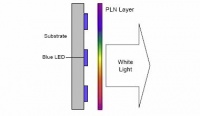When used in conjunction with a low-power LED, a high-efficiency lighting device can be built with the material that is capable of generating in excess of 55 lumens of light output per electrical watt consumed.
The researchers say that the efficiency is more than five times greater than that of traditional incandescent bulbs.
Additionally, the researchers claim that the technology produces an aesthetically pleasing light with better colour-rendering properties than are typically found in compact fluorescent light (CFL) bulbs. They have demonstrated colour-rendering indices in excess of 90 for warm-white, neutral-white and cool-white illumination sources.
’Because lighting consumes almost one fourth of all electricity generated in the US, our technology could have a significant impact in reducing energy consumption and carbon-dioxide emissions,’ said Dr Lynn Davis, director of RTI’s Nanoscale Materials Program.
’The technology also does not contain mercury, which makes it more environmentally friendly and safer to handle than CFLs and other fluorescent lamps,’ she added.
RTI is continuing to develop the technology and is actively pursuing commercialisation opportunities in the marketplace. It is anticipated that commercial products based on the technology will be available in three to five years.






Project to investigate hybrid approach to titanium manufacturing
What is this a hybrid of? Superplastic forming tends to be performed slowly as otherwise the behaviour is the hot creep that typifies hot...